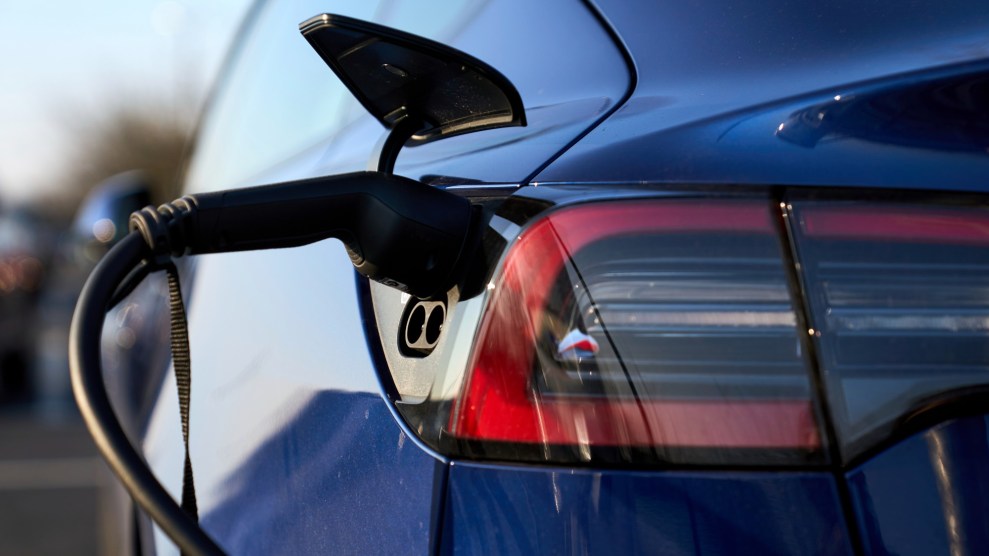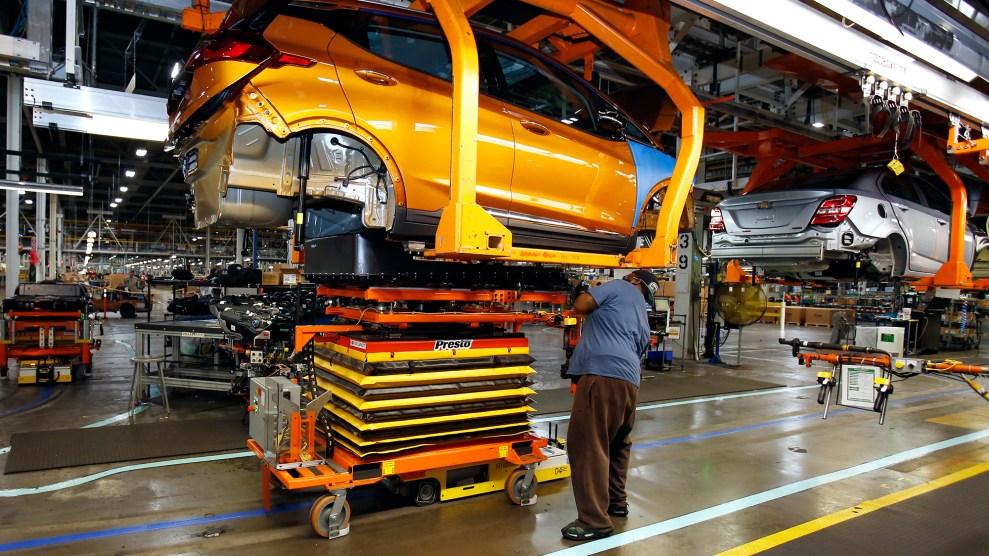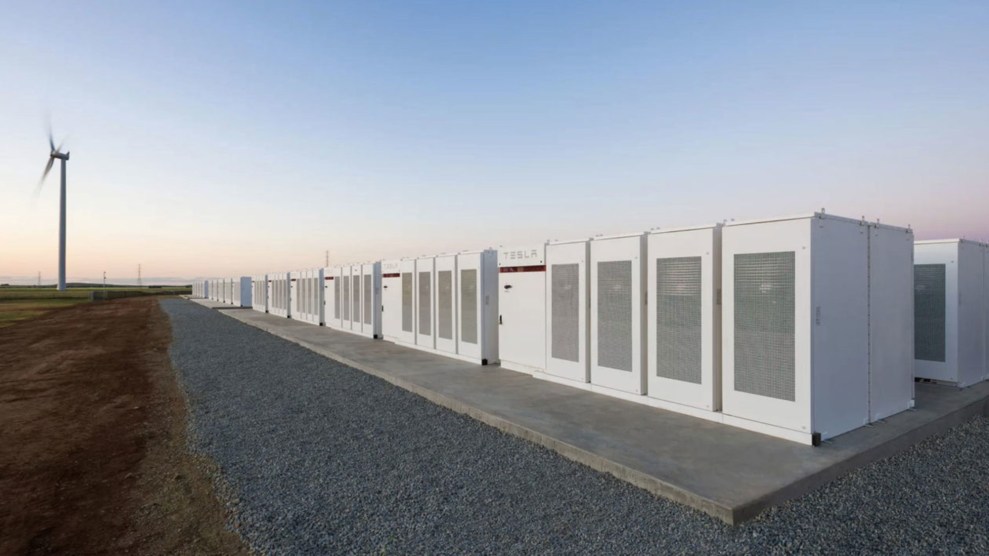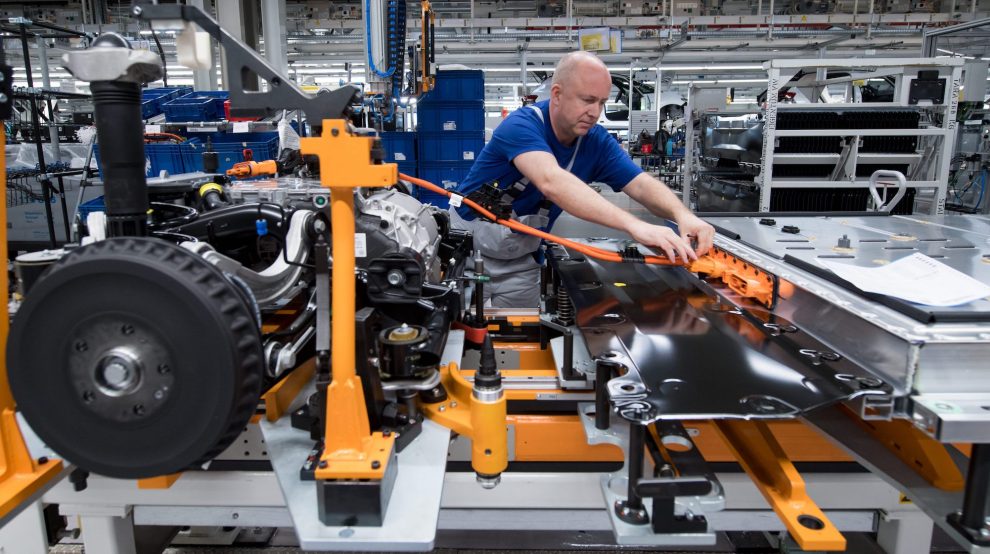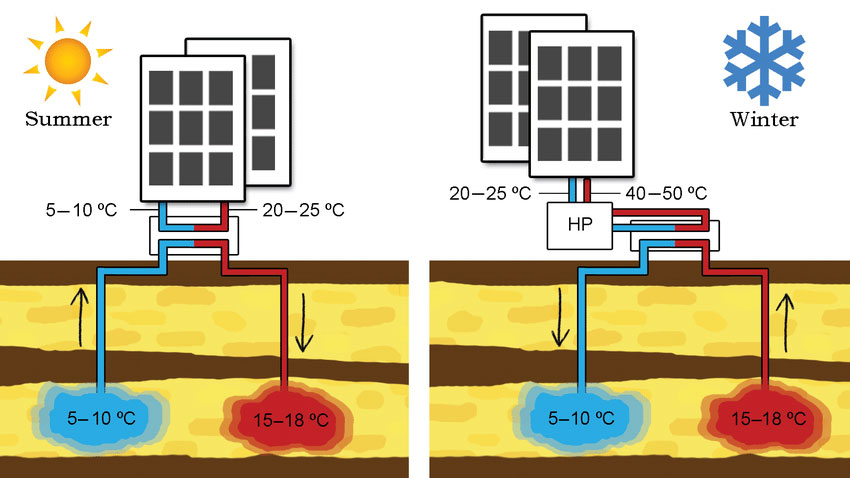
Working principle of an aquifer thermal energy storage system.Martin Bloemendal and Theo Olsthoorn
This story was originally published by Wired and is reproduced here as part of the Climate Desk collaboration.
When rainwater falls, it soaks down into an aquifer, a layer of porous rock or loose materials like sand or gravel. For thousands of years, humans have been digging into these bands of liquid to bring up drinking water. But interest is growing in another clever use for these subterranean pools: aquifer thermal energy storage, or ATES.
A battery holds energy to be used later. Aquifers can be leveraged to do something similar: They can exploit the insulating properties of the Earth to conserve thermal energy and transfer it to and from buildings above ground. The temperature of water in an aquifer tends to stay fairly stable. This provides a way to heat and cool nearby structures with energy stored in water, instead of burning natural gas in furnaces or tapping into fossil-fuel-derived electricity to run air conditioners.
ATES systems consist of two separate wells—one warm, one cold—that run between the surface and the aquifer below. In the winter, you pump groundwater up from a warm well that’s around 60 degrees Fahrenheit, and run it through a heat exchanger. Combined with a heat pump, this process extracts heat from the groundwater to keep the structures’ interiors warm.
Then you pump that now-cooler groundwater down into the second well. This gives you a cold pool of water—around 45 degrees F—to pump out of in the summer to chill buildings. “You heat up the groundwater by taking out the heat from the building and directly inject it into the other well,” says hydrogeologist Martin Bloemendal, who studies ATES at Delft University of Technology in the Netherlands. “Then in winter, you extract from your warm well.” This process alternates indefinitely as the seasons roll on because the groundwater is reused, not consumed. The system could even take advantage of brackish or contaminated aquifers that can’t be tapped for drinking water.
Because the water pumps and other equipment are run on renewable power, like solar or wind, this hyper-efficient energy storage would lower fossil fuel demand and keep a lot of carbon from entering the atmosphere. Heating and cooling are responsible for a third of energy consumption in the US, and half of energy consumption in Europe. In fact, a new paper in the journal Applied Energy found that ATES could reduce the use of natural gas and electricity in heating and cooling US homes and businesses by 40 percent.
It’s a way to store massive amounts of energy for long periods of time—an underground battery of sorts, always ready to exploit. “In a local city, you can store heat, and you can store cold, and now you don’t have to pay for that later,” says Erick Burns, the United States Geological Survey’s leader for the Geothermal Resource Investigations Project. (The USGS is part of a new international consortium that’s investigating city-scale geothermal energy.) “The cool thing about it is it doesn’t need critical minerals, like batteries do.”
The technique is ideal for large buildings, like hospitals, or a cluster of buildings, like on a college campus, because they can share a dedicated facility for the well and other equipment. It would be particularly effective in times of high demand on the grid. In the US, demand spikes on late summer afternoons when people switch on their energy-hungry AC units. ATES uses far less power, which would lighten the load on the grid and help avoid crashes. If these systems could not only run off solar or wind energy, but be backed up by a distributed network of lithium-ion batteries, they could be resilient against power outages altogether.
“These systems are quite ideal when integrating renewables,” says energy systems researcher A.T.D. Perera, lead author of the new paper. (Perera is now at Princeton University but did the research while at Lawrence Berkeley National Laboratory.)
This technology is not yet widely deployed globally. Some 85 percent of the ATES systems are in the Netherlands, which has both the right geology and stringent national standards for energy efficiency. But one study found that swathes of Germany are suited for it; another found that almost a third of Spain’s population lives in areas suitable for ATES.
Not every area is a good fit, though. Unlike, say, a natural-gas power plant, a geothermal energy system depends on a host of complex geological factors. “It would be really, really difficult to say ‘OK, this system works well where I live in Illinois’ and then try to translate it to your home in California,” says Yu-Feng Lin, a geoscientist at the University of Illinois at Urbana-Champaign. (Lin is part of the international consortium with Burns but wasn’t involved in the new paper.) “It’s not as simple as copy-paste.”
For example, a city built on solid rock has no easy access to an aquifer. And even one that does have access needs sufficient “hydraulic conductivity,” meaning that water easily flows through underground materials like sand and gravel. The better the water flows, the easier and less energy-intensive it’ll be to pump it out.
That said, it can’t flow too much, because when you pump water down it may migrate elsewhere across the landscape. “You want it to flow when you want it to flow,” says Peter Nico, a geoscientist at Lawrence Berkeley National Laboratory who coauthored the paper with Perera. Luckily for the United States, Nico adds, “there are large swaths of the country that are in good shape for it.”
But there is another challenger: ATES is expensive. It requires thoroughly studying a given city’s geology, then paying to drill and set up the pumping equipment. But at least that cost is up front: Once you’ve got wells and pumps, it all runs on abundant, free solar or wind power. Plus, it’s not taking up much space at the surface, leaving room for urban gardens and other open green areas that cities need more than ever. “If you’re willing to pay a little bit more in order to improve climate resilience or become more sustainable,” says Perera, “this would be an ideal way to go.”
